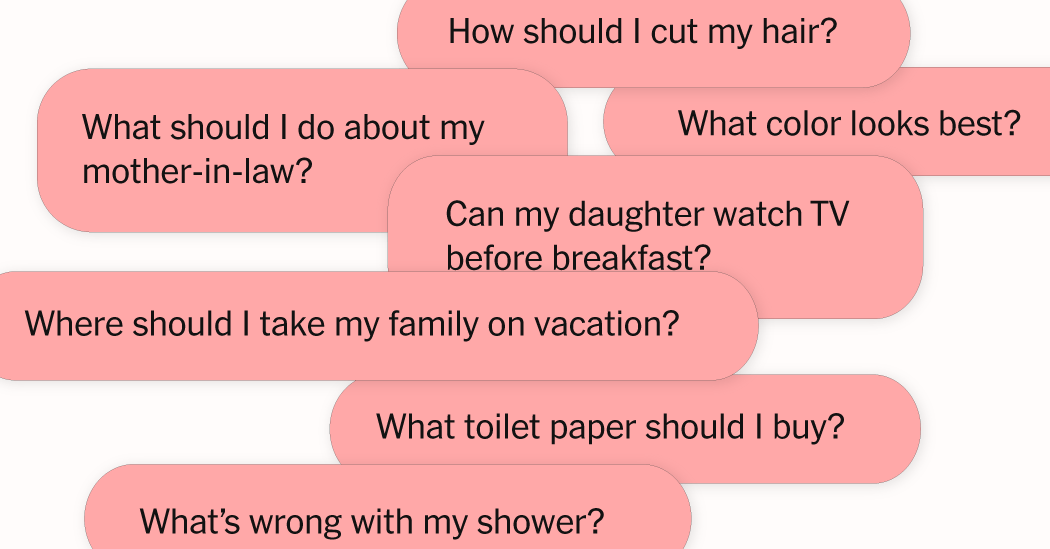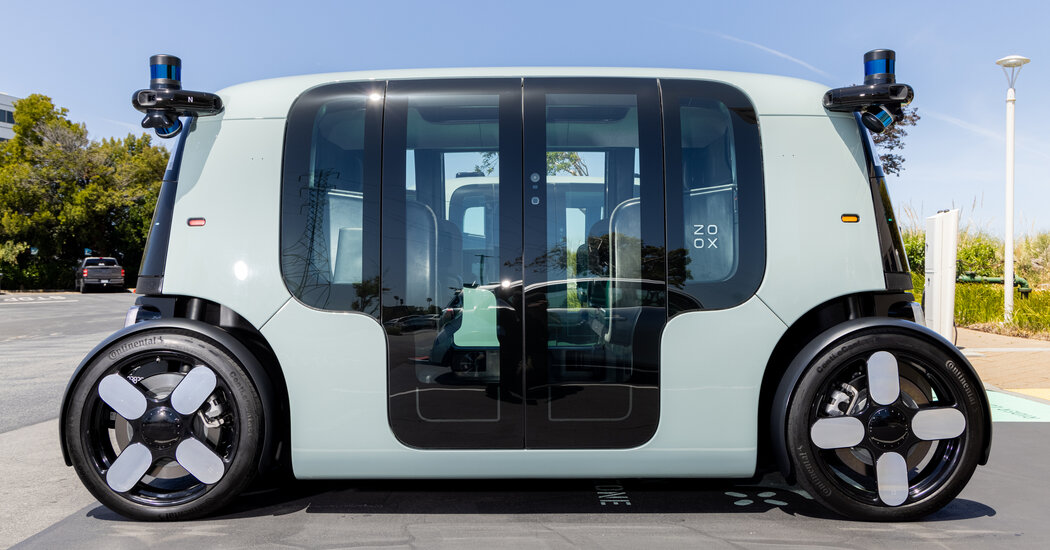I was scrolling through Instagram recently when I found a new page slipped into my feed through a suggested post: @tinyhouseperfect. It seemed designed to poke at my frustrated longings for a space of my own. I want to own a house; I cannot currently buy a house. But what if the house were very small? Very small, and also perfect?
Soon I was navigating the reading nooks and chef’s kitchens of an elfin cottage, a gothic coastal A-frame, a cozy “loch house” in the Scottish Highlands. I had projected my future self to the Scottish seaside, wondering how much the house might cost to rent for a weekend, when I realized that price was no object because the house did not exist. Each of these teensy homes had been rendered by A.I. software and smoothed with an assist from more A.I. software. I had been fantasizing about a fantasy.
The nature of these homes was, in retrospect, obvious. Their interiors appeared improbably expansive, offering room after room of curated delights. It’s not hard to imagine why Instagram might boost @tinyhouseperfect’s computer visions into my sightline. I have not hidden my obsession with homeownership and renovation from the internet’s all-seeing eye. At night I wander between Zillow and D.I.Y. Instagram accounts, stalking the hallways of homes I will never visit, assessing the work of contractor-influencers I will never employ, weighing aesthetic choices I will never make. Now artificial intelligence has breached my domestic fantasy, reshaping my desires to fit inside its phantom walls.
In recent years, a whole A.I. dream-house economy has materialized. Search Pinterest for décor inspiration, and you’ll find it clogged with artificial bedrooms that lead off to websites hawking cheap home accessories. “House porn” accounts on TikTok and X churn out antiseptic loft renderings and impossible views from nonexistent Parisian apartments. The website “This House Does Not Exist” generates random new homes upon command. And dozens of A.I.-powered design services and apps — among them SofaBrain and RoomGPT — churn out slick images tuned to your specifications.
A jangling set of house keys was once synonymous with American success: the striver’s ultimate prize. The misery produced by this idea (see: the Great Recession) has not dampened its allure. Now, thanks to elevated interest rates, insufficient supply and corporate landlords snapping up that limited housing stock, homeownership is more unrealistic than ever. A.I. houses just make that unreality explicit. In the virtual market, the supply is endless, and the key is always in the lock.
From Nowhere, and Everywhere
Housing voyeurism has always encouraged a measure of psychic projection. On TV, the celebrity house tour and the home-improvement program are older than I am. Magazines of aspirational domesticity are older still. In the 1970s, Architectural Digest transformed from a trade publication into a showcase for publicizing the private spaces of what it called “men and women of taste, discrimination and personal achievement.” In the 1980s, viewers of “Lifestyles of the Rich and Famous” were prompted to imagine how they might spend their millions if they had them.
This was the lousy trade-off of American inequality: The rich got lavish homes, and everyone else got to see the pictures, and experience the release that comes from judging all of their choices up close. At the end of each “Lifestyles” episode, Robin Leach bid his audience “champagne wishes and caviar dreams.”
The modern version of “Lifestyles,” the Netflix reality show “Selling Sunset,” focuses not on the people who live in Hollywood mansions but on the glamorous real estate agents who sell them. As these intensely groomed Realtors prep and stage fancy homes, viewers are invited to imagine not living in a mansion, but bringing it under our total financial and aesthetic control. Artificial intelligence and predictive algorithms only enhance this sensation of personal ownership, making a dream house feel as if it were built just for us.
The loch house on @tinyhouseperfect first caught my eye with its glistening waterfront views from vast windows, but when I looked again, I begrudgingly acknowledged that it had also appealed because it seemed to have been appointed to suit my personal tastes. There was a claw-foot tub with pewter fixtures, a charmingly messy bookshelf window-seat, a kitchen painted a cool green. In the place of cabinets, it featured exposed wooden shelves stocked with shapely glass jars of potions and preserves.
I had thought of the loch house as remote, but really it had come from nowhere, or everywhere. It was crowded with design touches perfectly synced to the ones cresting on my Instagram and Pinterest feeds. The “personal taste” that drew me in was actually a highly impersonal taste: an aesthetic that dominates my internet browsing so thoroughly, it has come to feel like I selected it myself.
In “Filterworld: How Algorithms Flattened Culture,” Kyle Chayka describes “the strangely frictionless geography created by digital platforms” and “the sense of vaporousness and unreality” created by the existence of, say, barely differentiated hipster coffee shops in every city in the world. This airless sensation has overtaken our collective imagination, too, infiltrating the spaces of the mind.
Even as social media and artificial intelligence bend us toward a ubiquitous megastyle, its products are often pitched as centers of creativity. An Architectural Digest article on A.I. design tools describes them as offering a “fresh perspective” that can “inspire architects” to think “outside the box.” But though A.I. prompts are seemingly endless, the results are often eerily banal. Much of the A.I. décor that surfaces on Instagram features the same uncanny images: liquid throw blankets, accidentally surreal wall art, hearths lit with inert flames.
These renderings are cheap, and yet it feels as if the flattening of design affects the homes of the wealthy most of all. I don’t use A.I. software, but I have a little game I play to refocus my housing fixation onto absurd and impractical spaces. I dial up the price settings on the Zillow app so that its map of the city reveals only properties that are listed at over $10 million, over $50 million, over $100 million. As the costs climb, the profiles of potential buyers grow more obscure and mysterious until they do not seem to exist in my world at all, and the tastes on display start to look, themselves, mechanically programmed.
Watching old episodes of “Lifestyles and the Rich and Famous” and its spiritual successor, “MTV Cribs,” it’s striking how similar the homes of the wealthy appear. In a 2004 episode of “Cribs,” Snoop Dogg opens the door to his manse, revealing a parlor with granny furniture and a gigantic urn; the room could fit into the home of Debbie Gibson, profiled on “Lifestyles” in 1993. Now, every property on “Selling Sunset” feels laser cut from the same blueprint, every mansion a flat box of ostentatious minimalism. The $195 million Manhattan penthouse currently perched atop my Zillow feed is just a gargantuan version of the glass-box look replicated across every luxury condo building in New York City.
A very rich person has the resources to dramatically transform a space in response to trends, lending wealth itself an artificial aesthetic. An Architectural Digest tour of Drake’s Toronto mansion looks as if it were designed by a bot, with its cartoonish proportions, glassy surfaces and random, click-and-paste patterns. And the magazine’s tour of the influencer Emma Chamberlain’s home feels eerily saturated with buzzy designs: the bulbous couch, the egg-shaped stone dining table, the wavy velvet chair. Even the unexpected details feel intentionally programmed. Now, as I swipe my way through the bedrooms of an A.I.-rendered home, I can produce that same mechanical sensation.
No People, No Animals
The loch house I coveted was created by Ben Myhre, a Norway-based designer who started conjuring architectural concept art with A.I. software a couple of years ago and posting it to Instagram, where he has accrued more than 500,000 followers. Unlike some of the uncanny renderings that choke social media, Myhre’s bespoke images take many hours to build, with the help of his own photographs of buildings, the generative A.I. program Midjourney, the A.I.-powered photo enhancement program Topaz, and Photoshop. In addition to adorable little houses, he makes images of homes inspired by Harry Potter, Santa Claus and “The Lord of the Rings.”
I reached out to Myhre and spoke with him over Zoom. “I like to use it to unlock dreams,” he said of artificial intelligence, which he sees as a form of “collective imagination that anyone can access.” I was curious about the contours of the imagination animating his dream homes, and he shared some of the prompts he used to create the loch house. He guided the software to create a “cozy whimsical house kitchen in the beautiful Scottish highlands,” one with “window views to a vast scenic loch view with early autumn nature.” He called for “rustic details,” “depth of field,” “warm tones,” “style raw.” And he asked to banish certain elements: “no people, no animals.”
No people, no animals. Part of why Myrhe’s images can seem “real” is because they are created in the style of an online home tour, the kind you might find on Zillow or Airbnb. But I hadn’t totally understood the appeal of his work until he said those words; the fantasy is of spaces wiped of living things. There is a postapocalyptic feel to the home-sale slide show and its A.I. counterpart. The houses feel urgently abandoned, a book cracked open on the armrest, a fire still glowing. When I “toured” the loch house, I was inspecting its shelf of corked jugs, wondering where the residents had stashed all their practical kitchen items, when I finally realized that there were no residents. Nothing needed to be cooked for nobody.
Myhre told me that his images sometimes upset people who were expecting pictures of actual homes. “When people realize they’re not real, they feel a bit tricked,” he said. In his captions, he pleads with those (like @tinyhouseperfect) who circulate his work: “Please be sure to credit if you share and clearly label they are imaginary A.I. assisted scenes to avoid any misconceptions.”
But there is a seduction to the unreality of these images, too. My trips through Zillow are fueled by my jealousy at the actual residents of the homes I can only inhabit with my mind. There is nothing “real” about my fantasy of living in places I can’t afford, even as my brain sets to work studying the floor plan and arranging my furniture in its rooms. Touring a lavish house, whether it’s on Zillow or “Selling Sunset” or @tinyhouseperfect, distorts my vision in another way: It makes me feel as if I’m lacking something, when I have more than enough.
No human lives in the loch house, but increasingly this is also true of real dream homes. Many of New York’s luxury apartments lie empty. Some are acquired by the ultrarich as assets. They exist to house no one, even as people sleep on the streets outside. Home voyeurism has always been a form of misdirection, a glittering diversion from our inability, or refusal, to shelter everyone. It coaxes us to think of housing as a lifestyle choice, not a right. A.I. houses complete the trick. They represent housing that is finally freed from any responsibility toward human beings. No shelter, only vibes.







